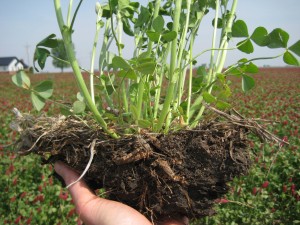 This year's drought is especially hard on livestock - there's not much growing for them to munch on. Today we learned that sixty-four Indiana counties are now "primary natural disaster areas" due to the lack of rain, and Conservation Reserve and Wetland Reserve acreage has been opened up for emergency forage and haying.
This year's drought is especially hard on livestock - there's not much growing for them to munch on. Today we learned that sixty-four Indiana counties are now "primary natural disaster areas" due to the lack of rain, and Conservation Reserve and Wetland Reserve acreage has been opened up for emergency forage and haying.However, according to Dave Robison at PlantCoverCrops.com, "Harvesting cover crops for emergency fall forage may be able to play a major role in lessening the impact of the 2012 drought disaster for livestock producers."
His article is copied in part here; you can read the full version here.
"I have received phone call after phone call from dairy and beef producers asking what cover crops they can use to provide food for their animals this fall and winter. Below I have listed a variety of choices that may work well for producers needing feed (if we get rain). By the way, these choices are also excellent cover crops."
Dave recommends these crops for forage:
- Sudangrass or Sorghum X Sudangrass
- Spring Oats/Spring Triticale
- Oats and Crimson Clover
- Oats and Cereal Rye (or Winter Triticale)
- Oats (or Spring Triticale) and Peas (Forage or Austrian Winter Peas)
- Annual Ryegrass/Annual Ryegrass – Crimson Clover Mix or Italian Ryegrass
- Spring or Winter Barley
